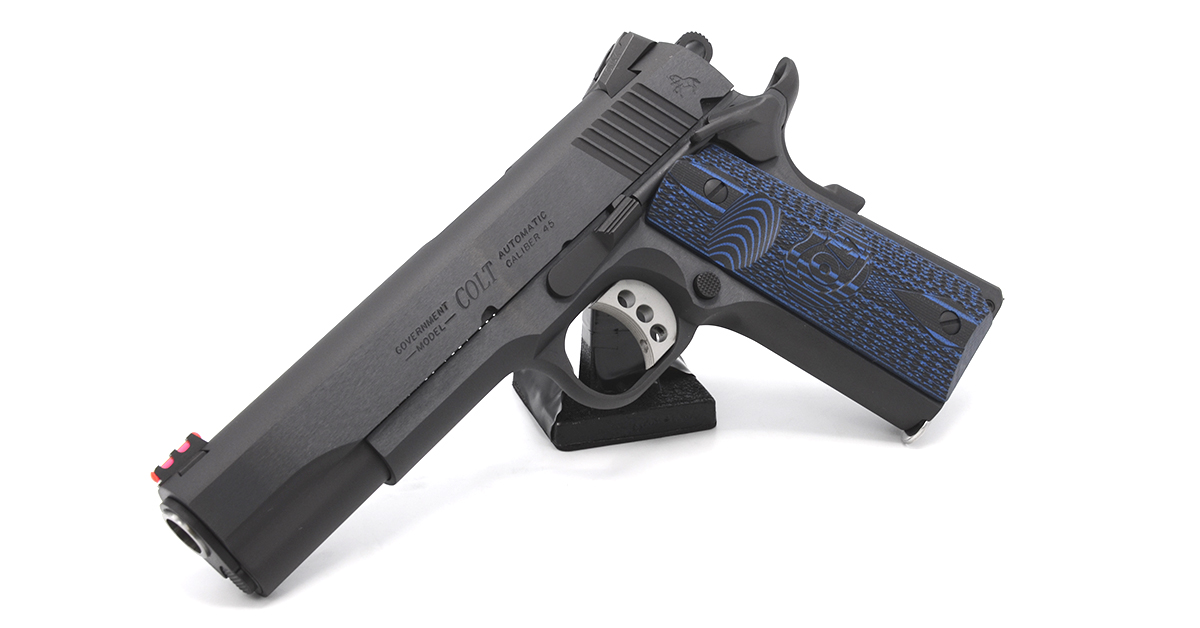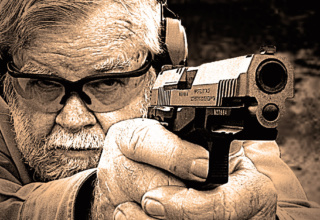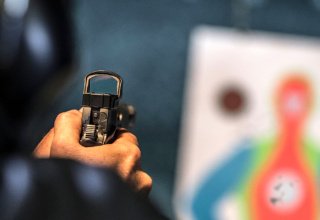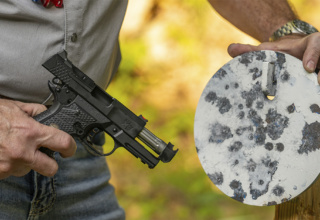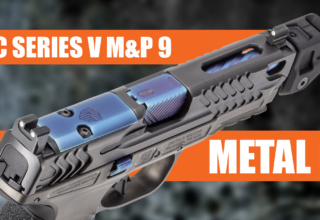No stranger to high-end race guns and with decades under his belt shooting the cream of the 1911 world, our author achieved his lifelong best performance with Colt’s production model Competition 1911
by Bob Campbell
Colt 1911 handguns are famed for their wartime service. Colts in the hands of Frank Luke, Corporal Alvin York, Lawrence of Arabia, and many others served like no other handgun. On the civilian side, Frank Hamer, Lone Wolf Gonzaullas, and many Texas Rangers used the Colt.
But there is a another side to the 1911 as well. The Colt has been used in competition at the National Matches for more than one hundred years. The original specifications for the 1911’s acceptance into service demanded a five-shot group of five inches at 25 yards and ten inches at 50 yards. When the bullseye was at 50 yards, more precision was needed. Army gunsmiths welded up and carefully fitted barrels and worked the trigger action to a smooth, reliable instrument. All we have in custom 1911 handguns today began in those shops.
Interestingly, the original Colt National Match wasn’t a target-sighted pistol with bullseye recoil springs. The National Match featured large, fixed sights. Most of the matches were shot with 230-grain hardball full-power ammunition. The pistol reviewed in this installment has much in common with the original National Match. The Colt Competition is a go anywhere, do anything handgun that is among my favorite 1911 handguns of all time. They are available in both .45 ACP and 9mm Luger. My example here is a .45 ACP.

Colt has some experience with 1911 handguns and the pistol illustrated clearly exhibits modern features that make it a good shooter. The original Colt Competition is a similar handgun. This pistol, however, differs in some details.
The front sight of the original issue featured a blue fiber optic. While it was fashionably matched to the pistol’s trademark blue grips, blue isn’t a high visibility color. The new gun features a red fiber optic. A more significant change is that the lockwork is now Series 70.
There is no firing pin block. This makes for a superior trigger action from the factory. Safety is retained with a heavy-duty firing pin spring. If you don’t drop the 1911 directly on the muzzle from six feet, all are drop safe! It is possible to obtain a good trigger action in a Series 80 gun but if you tune to the nth degree, get a Series 70. That said, I no longer touch a trigger action in a 1911. There are too many good trigger components originally set for a superb trigger pull to take a chance by filing on a trigger and sear engagement. This is especially true in handguns of mediocre quality with poor quality internal components.
The Colt Competition 1911 also features a dual-spring recoil system while retaining the original recoil guide — there is no full-length guide rod. This arrangement seems to harness recoil well. This competition-oriented handgun is actually one of the finest handguns available for personal defense use. There is nothing in the Colt Competition that would keep the pistol out of a concealed carry holster. It is simply refined a bit for competition use. The Competition Series isn’t a full-blown target pistol, though, like the Gold Cup or National Match. The Competition is distinctive with the deep blue finish Colt is renowned for. The secret, of course, is in the polish before the pistol is put into the bluing tank. If you prefer a stainless-steel handgun, Colt offers a version in stainless as well. The handgun features nicely checkered G10 grips molded in blue.
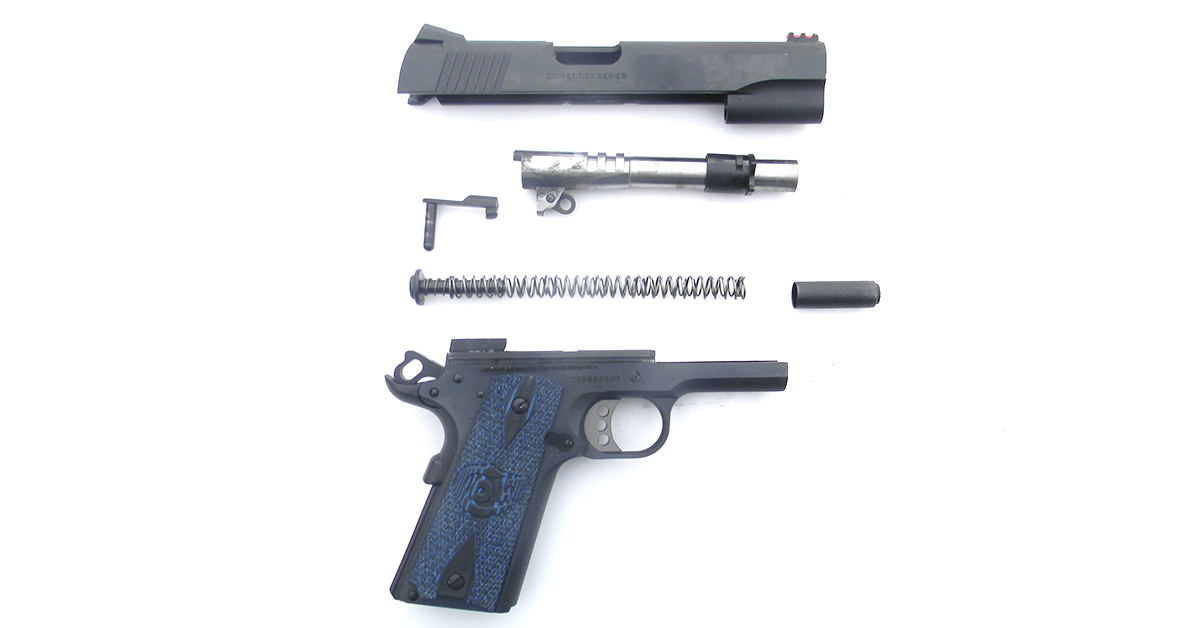
Also included is a traditional round top slide. A dovetailed front sight contains a fiber-optic insert. The Novak rear sight is adjustable for elevation by turning a screw. Windage adjustment is more complicated. You must loosen a set screw and then bump the sight laterally. I did not adjust the sights during the test as they were well regulated for the six o’clock hold at 25 yards with 230-grain loads.
The ejection port is nicely scalloped. While small slide windows are fine for cartridge case ejection, a large ejection port makes for easy unloading of an unfired cartridge. The barrel bushing is snug but not so tight it needs a bushing wrench for removal. The feed ramp is well polished with the proper 1/32nd-inch gap between the two halves of the ramp. There are no forward cocking serrations — a feature I can live without. The slide and plunger tube work well, with the plunger tube properly staked in place.
I have walked away from 1911 handguns without a proper safety indent. The safety indents firmly with a sharp snap. The grip safety properly releases its hold on the trigger about half-way into its compression. The grip safety is a memory groove-type. I like this a great deal since the design helps funnel the hand onto a high hold on the grip. Along with a slight undercut behind the trigger guard, this beavertail safety helps present a low bore axis.
With the centerline of the bore lower over the hand, muzzle flip is limited. There is less leverage for the muzzle to rise. For many of us using the thumbs-forward grip style, a 1911 pistol may create a cup in the palm. This beavertail alleviates that concern. I never missed depressing the beavertail safety during the shooting trials.
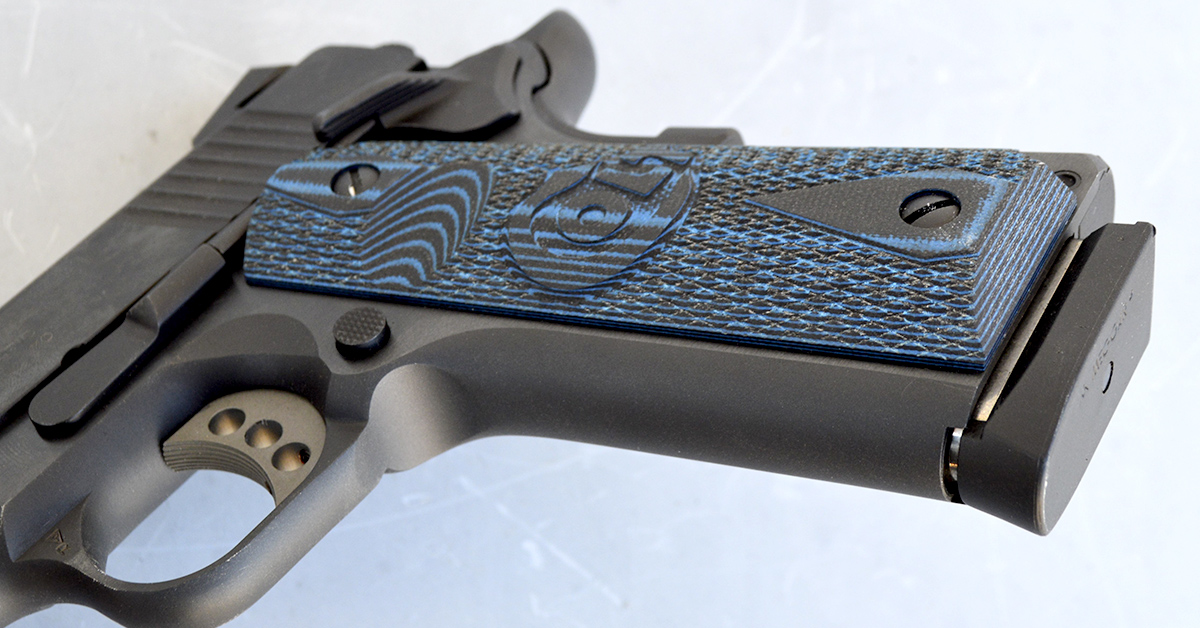
The trigger is an aluminum match type. The trigger action is sharp and smooth, breaking at just under six pounds (as measured on the RCBS registering trigger scale). Reset is important to speed shooting, and this trigger resets sharply. I cannot hear as well as I did but I heard the audible reset. This trigger is ideal for most uses.
The mainspring housing is flat and serrated. The magazine well opening is only slightly beveled. Clearance on the frame and slide and a snug barrel bushing add up to good accuracy. A GI type 1911 probably induces a rattle when shook at .010-inch clearance. I like a tighter fit — .0020 for both sides of the rails.
There is a lot going on when the 1911 fires. The slide recoils and the recoil spring is compressed. The spring must have enough energy to force the barrel up onto the lower locking lugs while the slide is lifted and travels to the rear.
An esoteric subject seldom broached is stacking play. It is difficult to define but understood by those who have ample work behind the 1911. Keep lateral clearance tight but allow this clearance to be sufficient to prevent sloppy lock-up. A tightly fitted gun has less slop and as a result eccentric wear is much less.
There is also the separate issue of the pistol’s extractor locking into the cartridge case rim and guiding the cartridge into the chamber as the cartridge nose bumps over the feed ramp. The feed ramp should have a 1/32nd-inch gap between the two halves and the feed ramp should be smooth.
There is confusion as to slide rails and slide ways. While I learned to fit up the 1911 in order that there was a clearance at the bottom of the slide, most 1911s now feature a slide that rides on the frame. And we get very good accuracy. I am impressed by the Colt Competition. There is enough of the human element involved that occasionally a pistol will be exceptionally well-fitted. I hope my Colt is one of these. It is a better shooter than a similar pistol I tested a few years ago.
The pistol was examined and then lubricated on the bearing surfaces, cocking block, barrel bushing, and barrel hood. I had the original two magazines supplied and added a couple of Wilson Combat magazines as well as a MecGar and a D&L Sports magazine.
The initial testing was accomplished with 230-grain FMJ loads. If a 1911 pistol or magazine doesn’t function with this load, it is sick. Most of the ammunition was Federal American Eagle.
The pistol performed exceptionally well. There have been no failures to feed, chamber, fire, or eject. Drawing and firing quickly on man-sized targets at 7, 10, and 15 yards, I had the usual excellent results with a 1911 pistol…and then some. The trigger action is smooth, straight-to-the-rear 1911, and smoother than most. As I fired, I allowed the trigger to reset during recoil. I am fairly certain I could teach an ape to press a trigger quickly, to stay on target, allow reset during recoil, and to reacquire the sights.
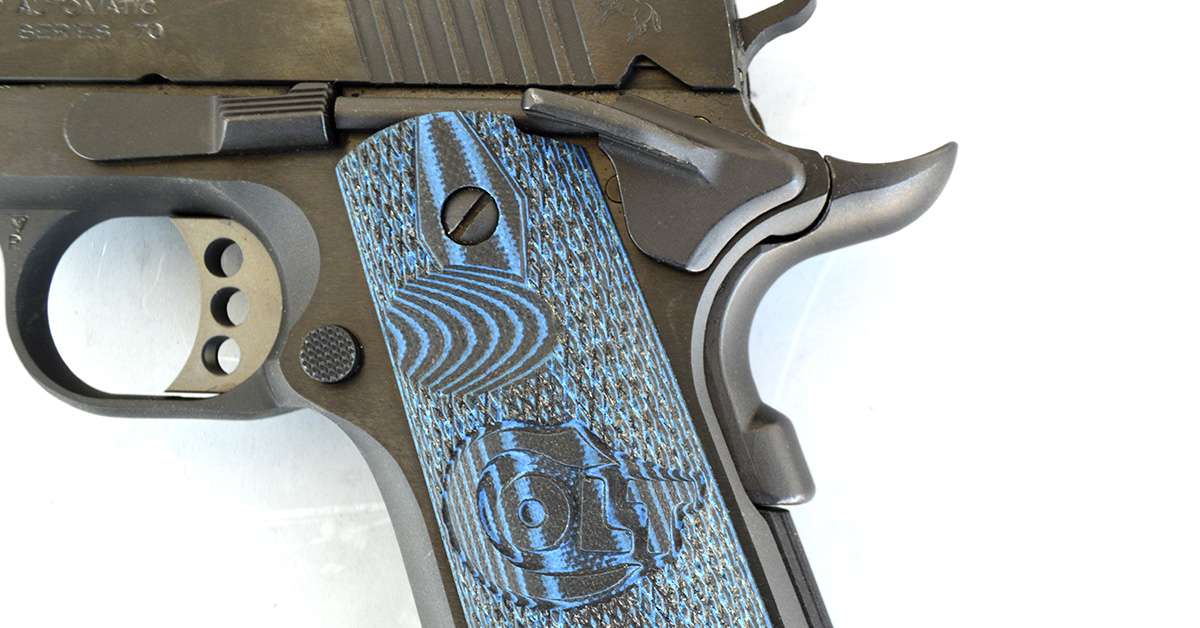
The red fiber optic sight is a great choice for most firing situations. The pistol was proving to be one of those handguns that is above average among excellent pistols. One hundred rounds of hardball is a lot of ammunition, but I did not have to rub my wrists after these were fired. A Government Model .45 at 40 ounces isn’t a hard kicker. The dual-wound recoil spring seems to harness recoil in a superior manner to my stainless steel Government Model carry gun. As a reference, the stainless Colt Government Model is a favorite I am very familiar with. I believe the single best five-shot group I have fired with this pistol from a solid bench rest with this handgun has been five shots inside of 2 inches. A group of 2.0 to 2.5 inches is very good for this type of handgun. I expected the Competition .45 to be in this category.
I had a pleasant surprise with this pistol. I fired the single best group I have ever fired with any 1911, any .45 ACP, and possibly any handgun. Only the Colt Python came close.
As a background, about 1996, I was firing a SIG P220 .45 ACP with Black Hills Ammunition 230-grain JHP ammunition. I fired from a solid benchrest at a measured 25 yards. While I fired three groups — and the other two were good but not as exceptional — five shots went into 15/16 inch in one effort. I have not duplicated much less beaten that standard. I am also no stranger to the Les Baer, Nighthawk, Guncrafter, and Wilson Combat 1911s. In the interceding time, I have yet to equal this group with any handgun. Such things stick in your mind. I often fire pistols I am intimately familiar with. This was the first range trip with the Colt. After a brief recess for lunch and to rest the eyes and trigger finger, I returned to the firing range and this time fired bench rest groups.
I chose four loads and would fire a five-shot group with each firing from the MTM Case-Gard K-Zone firing rest. The gun isn’t locked in place, but this rest is advantageous for accurate fire. I took a crush grip and concentrated on the sight picture. It is fine to concentrate on the front sight during rapid fire but for absolute accuracy you must perfect sight alignment and the sight picture must be superimposed over the target correctly. Here are the results:
- Black Hills 230-grain JHP; 1.6 inches
- Speer Gold Dot 230-grain JHP; 7/8 inches
- Fiocchi 200-grain XTP; 1.25 inches
- Hornady 185-grain XTP/Hornady Black; 1.5 inches
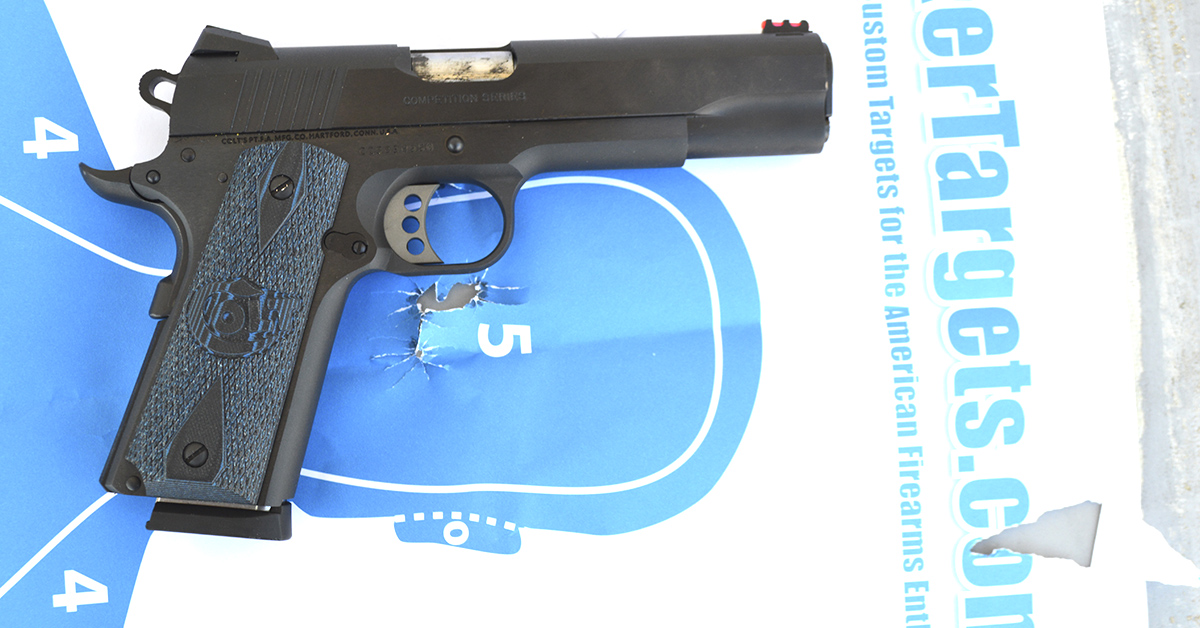
I measured the Gold Dot group several times. I broke my lifetime record! I am not likely to do that in any category in any pursuit at my age. I try to avoid being self-impressed, but this was out of the ordinary. Two more groups were fired with the Gold Dot load, with one at 1.25 inches and another at 1.5 inches. I also fired a 1.5-inch group with the Black Hills 230-grain load. It was time to pack it in and go home!
I should note that the largest group of the test represented exceptional accuracy. Firing off hand in the type of shooting that really counts, the Colt delivered excellent accuracy. The Colt makes the grade on reliability, accuracy, and handling. I won’t retire my stainless carry gun, as I like the short trigger and handling of the Government Model, but I am certain the Colt Competition will be riding with me often.
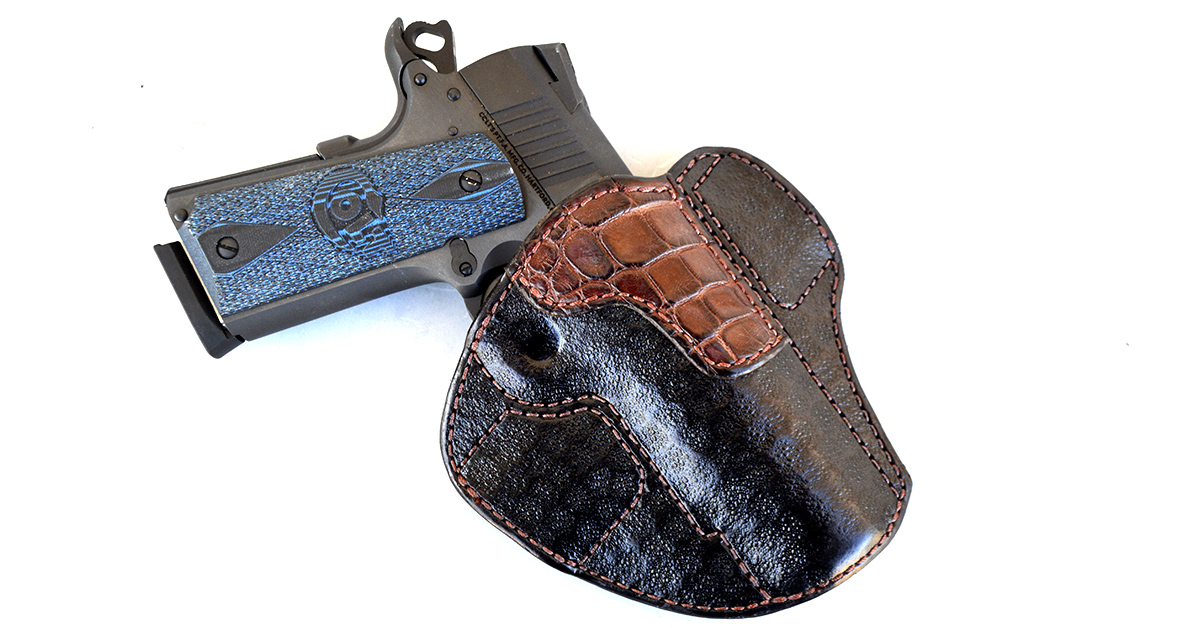
Carrying the Colt demanded a high-riding scabbard with a tunnel loop belt attachment. Jeffrey Custom Leather offers the Shadow — among the finest executions of concealed carry leather in my experience. This holster keeps the relatively heavy Colt .45 snug to the body and angled for the proper draw. Stitching is superb. A custom holster demands a break-in for real speed. The Shadow is lined and waxed, providing the user with an excellent balance of speed and retention. It simply doesn’t get any better.
What I Like
- I like the trigger action best. It’s not the lightest action but is very smooth and tight without creep or backlash. The sights are next. Reliability is certainly impressive.
What I Don’t Like
- I like a checkered front strap. I found no demerit in firing the Colt and never felt that a checkered front strap would have enhanced control. Just the same, I may add Talon tape or a Wilson Combat foil to still my search for druthers.
Compare To
- The balance of speed, accuracy, and power is comparable to the Springfield Loaded Model. The Loaded Model may not be as accurate, but it features an ambidextrous safety. The Kimber Custom II isn’t a bad gun at all, but it isn’t as accurate on average as a good Colt. A Dan Wesson Valor is more expensive but a very good gun.
Colt Competition Government 1911 Specifications
- Caliber: .45 ACP
- Barrel Length: 5 in.
- Overall Length: 8.5 in.
- Weight: 36 oz. (unloaded)
- Grips: Blue G10 checkered with scallop
- Sights: Novak front fiber optic, Novak adjustable rear
- Action: single-action, semi-auto
- Finish: blued

